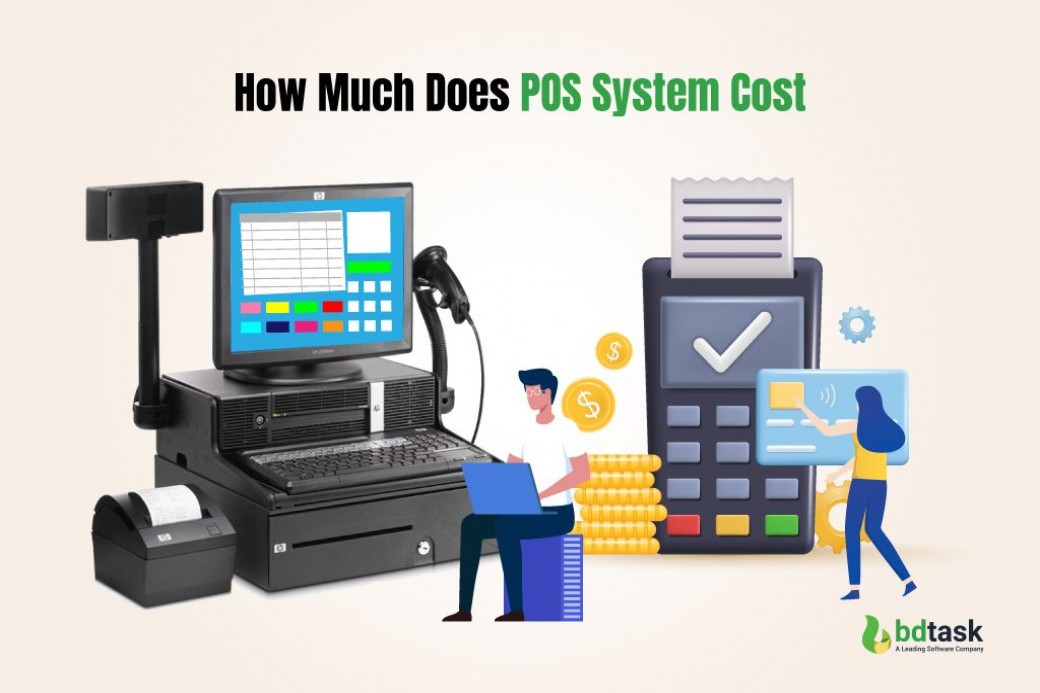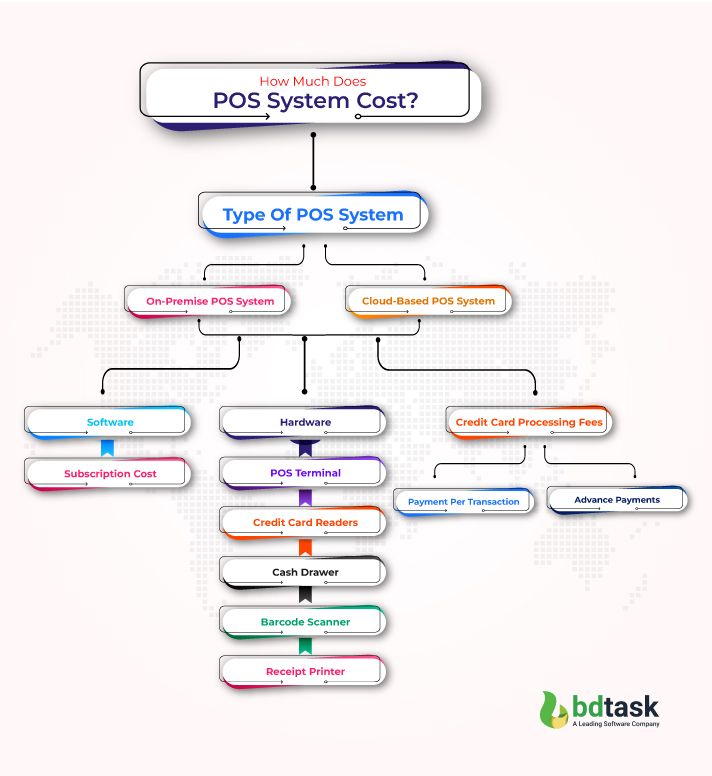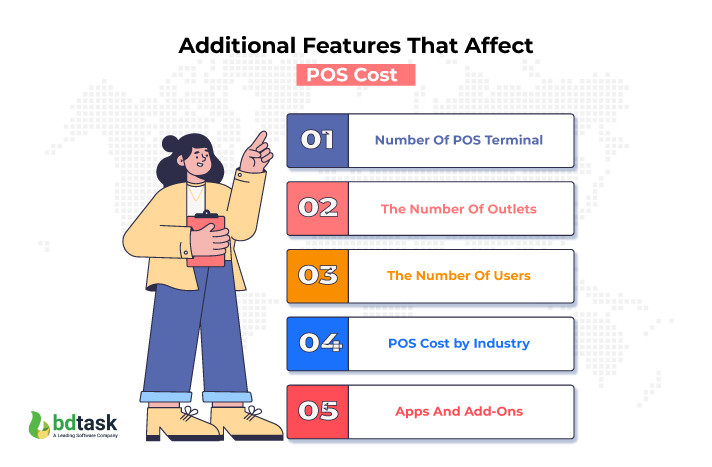How Much Does POS System Cost: Everything You Need To Know

POS systems are one of the core necessities for a restaurant business. Modern POS systems are much more than just a cash register. It’s a combination of hardware and software that streamlines a restaurant's daily process and helps manage its entire process more effectively. Nowadays restaurant owners are realizing how many benefits they are getting from a POS system. So they are more interested in purchasing a POS system for their restaurant. If you are one of them, then you might be struggling to create a budget for your restaurant business as you don’t know how much does POS system cost.
Many things affect the cost to raise and the cost to reduce of the POS system including the number of equipment, software setup, customization, payment processing cost, etc. The cost also varies on the size of your business and the number of restaurant locations or franchises you own. So there is no straight answer. You need to spend a reasonable amount of time on research to create the right budget for your restaurant POS system. To help you save time, we have done the hard work for you. We did all the research to create a clear image of how much does POS system cost. Continue reading the article to know the complete breakdown.
How Much Does POS System Cost?

There is no straight answer to the question, how much does POS system cost? POS system costs can vary depending on several aspects. Starting from the size of your business to the number of your restaurant locations. Also, the type of business such as a POS system for a fine dining restaurant is way more expensive than a POS system for a food truck. Moving forward from the type of POS system you are willing to integrate into your business to the installation cost, to the number of customization your business needs.
Then comes the quality and quantity of hardware equipment you want to purchase which also play an important role in this cost. Also, from the hardware which you must have if you want to use a POS system, to the hardware which is nice to have, to the hardware which is just an unnecessary luxury. Finally comes the payment processing cost.
Some additional factors which also impact the cost of a POS system are training, maintenance, and servicing costs. Furthermore, what kind of support facility the company you are purchasing a POS system for your restaurant is willing to give? It is one of the most important because as a new user with no technical knowledge, you might need help from the provider from time to time in the first six months. If the POS provider does not give you a good support facility in the first six months of purchasing the system, then you have to get support from IT experts. Which is going to add a good amount of expense to your check.
The average cost of point of sale system can range from 0$ to more than 1000$ as there are several POS system with no monthly fee available. Let’s look at the detailed description of each fundamental component that influences the cost of a POS system to climb upwards and go down.
Type Of POS System
The cost of a POS system depends on the type of POS system you are using. There are two different pos systems widely used among restaurant owners. And these are -
- On-Premise POS System
- Cloud-Based POS System
Let’s look at a brief description of each system and also the price range.
On-Premise POS System
On-premise POS system is also called a traditional point of sale. On-premise point-of-sale (POS) systems are, as their names suggest, networks of terminals or computers that are installed and connected at the physical location of the company. It operates inside the private network that is internal to your business and stores information, like as inventory levels and sales performance, on a local database, which is normally the hard drive of your personal computer.
Consider a traditional desktop computer, which often sits on top of a cash drawer and comes complete with a monitor and keyboard. Even though this is a fantastic choice for retail businesses. Extra smaller pieces of hardware that are compatible with the system and necessary for it to function properly need to be purchased for each POS terminal. As a consequence of this, the cost to install it may often be higher and it is common practice to have to pay for it.
An on-premise POS system can range from $3,000 to $50,000.
Cloud-Based POS System
Unlike on-premise POS systems, cloud-based POS systems run in "the cloud" which is a far-away web server that only needs an internet connection. Cloud-based POS software, usually runs on a tablet, like an iPad or an Android phone. This gives you the freedom to move around the store and make purchases. Many small businesses choose this option because it's less expensive and lets you see information from anywhere. This is great if you have more than one store. Because it's easier to set up, it often costs less to deploy the hardware and software.
Cloud-based POS system can cost from $50 to $100 monthly and a one-time set-up price of $1,000 to $1,500.
POS System Cost: Software, Hardware, Payment Processing Fees
When you are purchasing a POS system for your business you should keep a lot of things in mind. A POS system’s cost depends on many things. A POS system whether it’s a On-premise or it’s a Cloud-based POS system has 3 main factors of cost.
They are,
- Software
- Hardware
- Payment Or Credit Card Processing Fee
If you are considering purchasing a POS system, you must be aware of these 3 major factors and plan your budget keeping these three factors in mind. Let’s look at the complete breakdown of these three major POS cost factors.
1. Software
POS software price depends on many different aspects. Make sure the point-of-sale software you choose offers the features you need to run your company, such as inventory management, reporting and analytics, and interaction with your e-commerce platform before you start shopping for POS software.
The vast majority of point-of-sale or POS software is sold on a subscription basis, with many levels of service available at varying prices. If you are looking for a POS system for small business then keep in mind that the more costly the software subscription is, the greater the likelihood that it will have more complicated features.
➤ Subscription Cost
This is by far the most popular option. Even though you will not legally own the application, on the other hand, you do get full access to free automatic upgrades, good customer service, and other benefits such as managed PCI compliance.
The subscription cost of POS system for small business with a single POS terminal can range from 50 to 150 dollars per month. However, large businesses may have to pay more considering the number of POS terminals and other extended features which can range between 150 and 300 dollars per month.
2. Hardware
A point-of-sale (POS) system's outstanding feature is that it can be adjusted to meet your exact needs, whether they are simple or costly. Depending on business requirements, you can purchase, lease, or rent POS gear. However, the hardware you require is determined by the configuration of your shop.
A list of hardware you must need to effectively run a POS system is given below.
➤ POS Terminal
The first choice you have to make is whether to use a traditional POS system or a mobile POS system that can be installed on iOS or Android tablets and smartphones. The cost of a POS terminal depends on that. Traditional POS systems take up a lot more space on the counter than mobile POS systems, which can be moved around the store to serve customers wherever they are. It is possible for mobile point-of-sale stands to include a rotator that rotates the tablet so that the screen is facing the customers. This kind of display is known as a customer-facing display.
A pos terminal cost can range from $100 to $1000 depending on your need.
➤ Credit Card Readers
Whatever POS system you pick, you'll need a credit card reader capable of accepting traditional payment methods as well as mobile payments like Apple Pay and Android Pay. The cost of extra capacity and whether or not it is wireless and transportable varies substantially.
A credit card reader's price can range from as little as $25 to more than $1,000.
➤ Cash Drawer
While contactless payments are becoming more popular, 61 percent of retail payments are still done with cash. You should consider purchasing a cash drawer as well as a credit card reader that accepts tap, chip, swipe, and PIN payments. This guarantees that you may accept any payment method and always complete the deal.
Cash drawers cost between $139 to $159.
➤ Barcode Scanner
Instead of manually entering a barcode or looking for items, invest in a barcode scanner that will make checkout more efficient for your company. There are even wireless models available, allowing you to scan anywhere in your store.
Barcode scanners can cost between $200 to $200 depending on your requirements.
➤ Receipt Printer
Even though many customers would rather have an electronic receipt, you should still consider installing a receipt printer so that customers have the option of receiving a paper receipt.
The receipt printers might cost as little as $20 to more than a few hundred dollars.
3. Credit Card Processing Fees
Every time a customer uses a credit card to make a purchase, you have to pay to process the payment. The amount you pay in transaction fees each month is determined by the number of orders processed at your point of sale. Usually, third-party business charges for payment processing costs. Apart from the cost of the hardware and software, credit card processing fees are another major factor that affects the price of a POS system.
➤ Payment Per Transaction
Some POS system providers charge a transaction fee each time you make a sale using their software. And the amount varies according to the vendor. This may add up to thousands of dollars each year depending on the volume of your transactions. If you pursue this path, make sure to thoroughly evaluate providers and learn how they structure their fees and how this may affect your company's profitability.
Payment per transaction can cost up to 3 to 5 percent for every transaction.
➤ Advance Payments
In certain cases, your vendor will enable you to pay for a year or more in advance rather than making monthly installments. It can frequently decrease the overall cost. Smaller enterprises, on the other hand, may lack the capital required for this arrangement.
Advance payments can cost as little as $1,000 per year.
Additional Features That Affect POS Cost

Besides software, hardware, and payment processing cost, the cost of a POS system can vary depending on some additional features. Let’s look at some additional features that affect the cost of the POS system.
01. Number Of POS Terminal
Some POS systems charge merchants on a per-terminal basis also referred to as a register. Depending on the number of locations and staff, this might get costly. Especially if you want to provide each retail assistant with their own POS terminal to ensure efficient customer service.
For example, let’s imagine you have two businesses and eight employees, four at each store. To provide a POS terminal to each of your employees, you must commit to a monthly recurring payment per month, minus the cost of your monthly plan and one-time hardware charges. When you pay per POS terminal, you wind up spending more money each month.
02. The Number Of Outlets
While some POS companies charge per terminal or register, others charge a flat amount per retail location. This is especially useful if you want to have many POS terminals in your shop. When you pay per location, you may have an infinite number of POS terminals without incurring extra charges. There are no additional fees for adding new users or installing your POS software on additional tablets or smartphones.
03. The Number Of Users
Some POS systems limit the number of user accounts that can use a POS terminal. Some plans may have only one user license, but others may include an infinite number of users. Be certain that the POS you select allows you to generate as many staff logins as you require to keep your store running properly.
Your business is ever-changing. Employees will increase in number as your business expands. We want you to have all of the resources you need to expand your business. As a result, get a POS system that allows you to add an infinite number of users at no additional cost.
04. POS Cost by Industry
The price of a POS system can change based on what kind of business you have. For example, a POS system for a catering business has different needs than a POS system for a bar. Others, like retail stores, restaurants, food trucks, and cafes, have different needs and requirements for both software and hardware features. Because of these needs and wants, the price of a POS system can vary. For instance, a restaurant needs a way to take reservations, but a store doesn't. POS systems cost different amounts because of these things.
05. Apps And Add-Ons
Accepting payments, managing inventory, reading reports, and establishing a customer database should all be the natural functions of your POS system. However, add-ons or applications created by third-party developers can be a cost-effective method to add new functions, experiment with new techniques, and discover new ways to build your business. Despite the fact that certain applications are free, there are a few that are not. The applications you select might influence how much you spend for your POS every month.
The Bottom Line
After this long discussion, you already got a clear vision of how much does POS system cost. Now you can make a wise decision to create a budget to purchase a POS system for your business. You already know the aspects that affect the cost of your POS system. You can choose the right POS system for your business, keeping the necessities and requirements of your business in mind. You can take a better step while selecting things you must have and nice to have when you are purchasing hardware. And also you can choose between the features necessary and unnecessary when you are customizing the system. Despite the cost, the POS system brings uncountable benefits to your business from increasing revenue to streamlining daily business operations.










